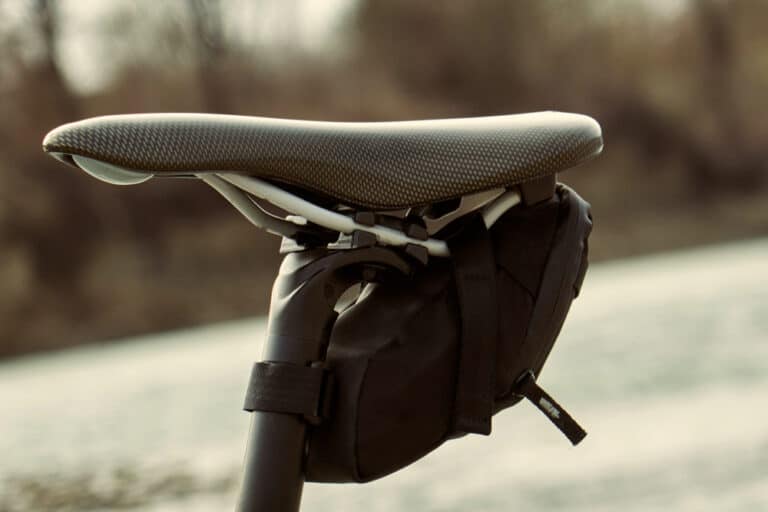Can Road Bike Go Off-Road?

Road and off-road bikes (mountain bikes) look completely different and are optimized for the individual uses they are designed for. With bikes being so expensive and a second bike being out of the reach of most of us, a commonly asked question is whether road bikes can be used off-road.
A road bike can go off-road; however, if you intend on riding an extreme trail or are considering entering an extreme sport, we recommend you use a fit-for-purpose bike. Road bikes are optimized for road use with lower wind resistance, narrower handlebars, and no shock absorbers.
Not only is it possible to use a road bike for off-road purposes, but a sport has developed from doing just this. While Cyclo-cross has developed to a level where specialty bikes have evolved, it started life using road bikes for off-road competitions.
It Is Possible To Go Off Road On A Road Bike
While a road bike may not be able to handle extreme off-road conditions, it is possible to use it for more gentler off-road routes.
To make the journey easier, the only real modification we recommend is installing as wide a tire as possible. The maximum width you will be able to use will be approximately 1.1 inches (28mm.)
Be careful, and don’t choose routes that are too extreme. Trying to fly over big jumps and down cliff edges on a road bike, before you have the necessary experience, is a sure way to get hurt and damage your bike.
What Are The Limitations Of Going Off Road On A Road Bike?
The differences between a road and an off-road bikes (mountain bikes) are as follows:
- The bike tires on an off-road bike are wider than a road bike.
- An off-road bike has shock absorbers on the forks and under the seat.
- The handlebars on a road bike are narrower.
- The brakes on a road bike are generally smaller than those on an off-road bike.
- Off-road bikes generally weigh 10-15% more than road bikes.
Factors To Consider When Riding A Bike On Rough Dirt Roads
It is safe to ride a road bike off-road as long as you remember the bike’s limitations.
On normal dirt roads that are in good condition, there is very little difference between riding a road bike or an off-road bike.
The differences become apparent when the rider tries to travel over the following surfaces.
- Thick loose sand.
- Muddy areas.
- Narrow sections where a high level of balance is required.
- Very bumpy surfaces with jumps and drops.
Thick Loose Sand
One of the hardest surfaces to ride over on any bike is thick loose sand.
Even on an off-road bike with thicker tires, it is very difficult to carry on moving when it bogs down.
Road bikes have narrower tires which means they dig down deeper and more quickly, making continued movement almost impossible.
When traveling over soft surfaces, you need wider (and lower pressure) tires that won’t tend to indent the surface as much (or send gravel popping out as much).
If you are planning on riding a surface like this, and if you are in a position to do so, we recommend installing wider tires onto your road bike.
Muddy Areas
Muddy surfaces present a very similar problem to deep sand. The main differences are that the surface is much more slippery, and you will be splashed and streaked with mud before you finish.
Once again, if you can install wider tires, it will make the trip less difficult.
Narrow Sections Where A High Level Of Balance Is Required
If you are going to be traversing narrow paths, which have drops on either side, the extra width of an off-road bike’s handlebars makes it easier to stay balanced and upright.
The handlebars on a road bike are narrower which makes the rider adopting a lower, more hunched profile. This lowers the wind resistance making higher speeds possible.
While the rider of an off-road bike has a more upright stance, which is not streamlined it makes maneuvering at slow speeds much easier.
Very Bumpy Surfaces With Jumps And Drops
In these situations, the biggest difference between road and off-road bikes becomes very clear.
The heftier frames of off-road bikes are better suited to the forces generated by riding over jumps and over drops.
The shock absorbers on the front wheel struts and under the seat make for a much more comfortable riding experience over rutted terrain.
If you have a road bike and are considering riding over the most extreme surfaces, we caution you to reconsider.
Factors To Consider When Riding A Bike On Gravel
Always look and plan ahead when riding a “road” bike on gravel. Constantly keep a watch on the distribution of the gravel on the road.
Remember that the narrower handlebars on a road bike make it more difficult to stay in control when the lateral forces increase. This makes riding over gravel more difficult because the bike may cross thick gravel sections, increasing the sideways forces.
Stay clear of areas where the gravel has built up and is deep.
Traffic will smooth out the tire tracks, which sometimes results in them being very smooth, making it easier for the cyclist. Stay on the smooth, gravel-free surface by riding on tracks made by the car wheels.
You must be careful at the edge of the road, corners, and intersections. In these locations, the gravel may have been pushed out of the way by passing vehicles leaving deep spots which are very difficult to ride through.

How Does Off Road Biking Compare To Road Biking?
The style of riding, experiences and rewards between off-road biking and road biking are very different.
Off-road bikers tend to ride in lower gears where torque is important, while road bikers will look to ride in the higher gears where speed is paramount.
Off-road bikers must have a combination of core body strength and balance, whereas road bikers require very strong legs and tenacity for those long uphills.
At the extreme end of each sport, bikers have shared courage where an injury is a possibility.
Can I put Road Tires On A Road Bike?
For the best and safest experience, install the widest tires your road bike can take.
The maximum width your road bike can handle will be in the region of 1.1 inches (28mm). This will still be thinner than a true off-road tire, which starts at 1.20 inches (30mm.)
If your bike’s frame allows it, choose tires with tread, which will help with traction on the more slippery off-road stages.
Conclusion
A road bike can go off-road, but it is not designed for that purpose, so caution should always be exercised. We recommend that the tires be replaced before going off-road and that extreme courses be avoided.







